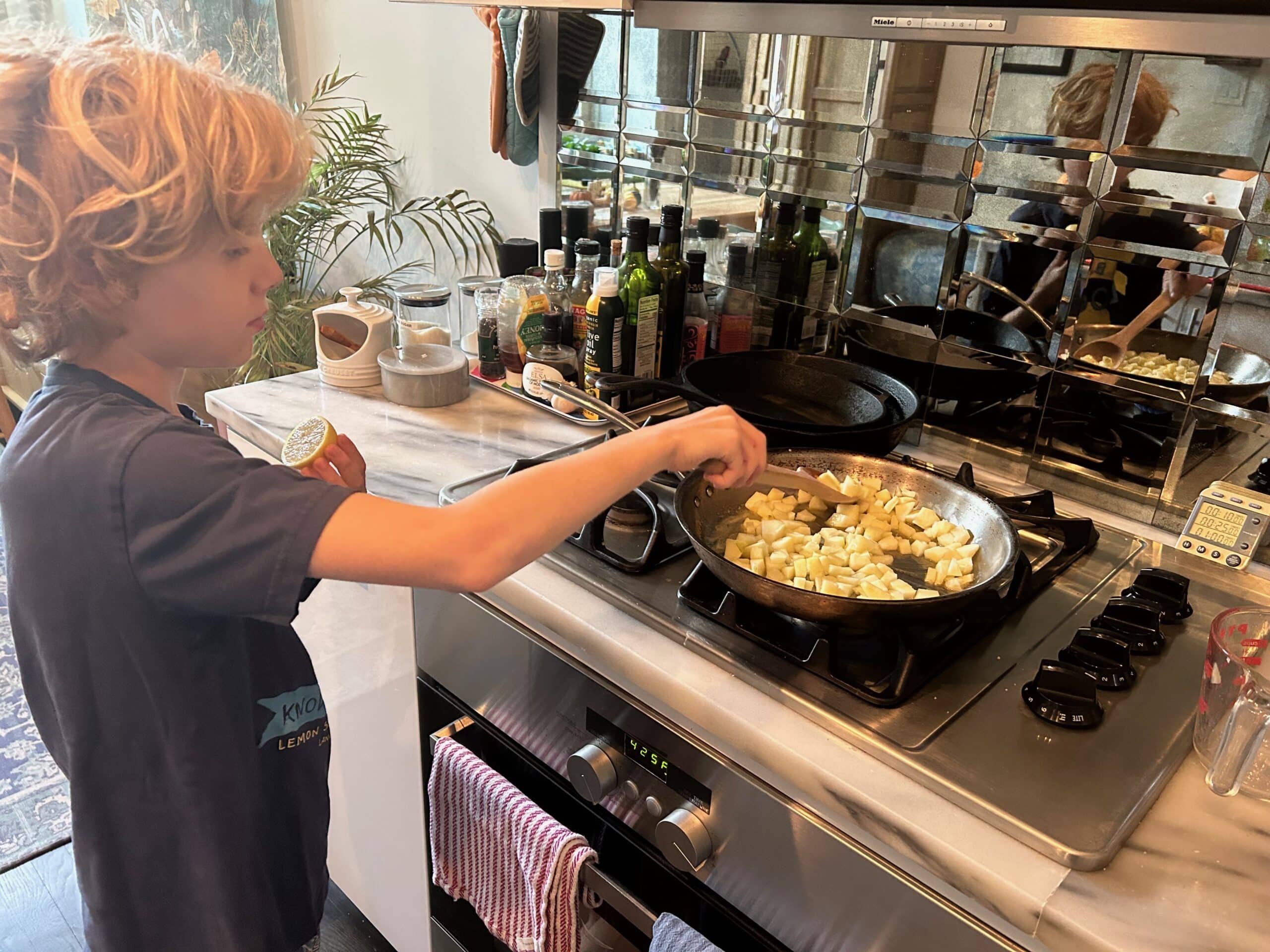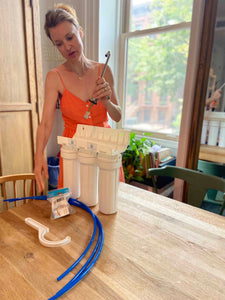Types of Toxic & Non-Toxic Cookware
Pots and pans come in a wide range of materials. Some cookware materials are okay, if you have the right variety, or if you don’t use them every day. Let’s go through these one by one, including the brands we recommend.
Nontoxic Cookware Materials
The following materials are always non-toxic. We will share our favorite brands made of these materials below, under The Best Stuff.
Carbon Steel
Carbon steel is sometimes used for frying pans and woks. It’s similar to cast iron, and can leach small amounts of iron into food, which is great if you have someone with slight anemia in your home!
Cast Iron
For most of human history, people suffered from iron deficiencies, so cooking with cast iron helped to prevent anemia. In modern cultures, the opposite is true. Most of us get plenty of iron, and there’s a point at which ingesting too much can be problematic. In our kitchen, we try to switch between cast iron pans and pans made of other materials throughout the week. If you want to be extra cautious, you could avoid cast iron for recipes with long cooking duration or acidic foods, as this will cause increased iron leaching.
Stainless Steel
Stainless steel pans are generally Good Stuff. The only caveat here is that stainless steel is made with nickel (the more nickel in the mix, the more “stainless” it is). The problem is that our bodies can handle some nickel, but too much isn’t healthy. This means that high quality stainless steel cookware, which has higher percentages of nickel, is actually of more concern than lower quality stainless steel! We know that stainless steel pans do leach nickel (along with some chromium and iron), especially with longer cooking times and when cooking acidic foods such as tomatoes. To minimize the potential for nickel leaching, you’d ideally want a pan that’s 18/4 or 18/0 stainless steel (that first number is the percentage of chromium; the second is nickel). I wouldn’t be concerned about using stainless steel as long as you just switch up your cookware. If you sometimes using cast iron and enamel pots and pans, you won’t be exposing yourself to too much nickel from stainless steel. If you’re still worried, you could avoid stainless steel when cooking acidic foods for long time periods.
Tempered Glass
Glass is probably the most inert of any cooking surface, and you can even get pots and pans made of this ultimate Good Stuff!
Titanium
Titanium is a non-toxic and biocompatible metal, so it is used for medical instruments, dental implant devices, and joint replacements. Titanium is also lightweight and extremely strong. Titanium cookware uses an aluminum base for even heat transfer and distribution. The non-porous, non-stick titanium outer surface does not allow any aluminum to leach through. The only reason to be cautious about titanium cookware is that it seems that most manufacturers now coat their titanium cookware with non-stick finishes, rendering it “Bad Stuff.”
Materials That May Be Safe in Cookware
When shopping for non-toxic cookware, some of these materials come in safe forms. Other times, they are treated (or untreated, as the case may be) in a way that renders them less safe.
Clay
Without testing a clay pot for every possible contaminant, you have no way of knowing what might be leaching into your food. Without a glaze on the pot, there is no protective barrier between what’s in the clay and your meal. The risks of unglazed clay pots and pans outweigh the potential benefits of the good minerals that might leach into your food—calcium, iron, etc.
Coated Ceramic
Made from natural materials such as clay and minerals, ceramic cookware offers excellent heat retention and distribution. Its non-reactive surface makes it ideal for cooking acidic foods, and it is also appreciated for its nontoxic nonstick cookware properties, requiring less oil or fat during cooking. Furthermore, it is generally considered safer than nonstick alternatives since it doesn’t contain potentially harmful chemicals like PFOA or PTFE. Ceramic cookware can be considered a safe less-stick if not truly truly non-stick material. Some ceramic cookware is coated with materials that may contain harmful substances like lead, cadmium, and other heavy metals. To ensure safety, it is crucial to choose ceramic cookware that is labeled as free from toxic materials and is certified as being compliant with safety standards.
Enamel
In essence, enamel is a form of glass. Enameled cookware is most often cast iron with an enamel coating. This type of cookware is wonderful to cook with. Some people have worried about lead in the enamel cookware, since the enamel coating is often made of clay, which can leach lead. For this reason, we suggest choosing high quality enamel cookware from well-known brands.









































247 comments
Dewitt
Dear Maia
Thanks in advance, DewittI would appreciate if you can tell me the safety of Woll cookwares. they are apparently made of Aluminum-titanium oxides or diamond crystals. Apparently they are non-stick. They are made in Germany.
Lisa
Hi, Maia-
Thanks for your comments! LisaDo you have any information on the Swiss Diamond brand of cookware? I am looking for something for my daughter. My experience using the one SD skillet that I own is excellent.
Sou C
Hi,
Regards, Sou CFirst I would like to say that I am very happy to have come across your website. I find the questions and answers were very helpful. My question for you is, would you by any chance know if
1) Le Creuset Dutch oven’s enamel contains any silicon?
2) The Staub’s manufacturer claims that the interior coating contains trace of quartz. Is cooking with quartz any health concerns?
3) Does Staub interior coating consists silicone?
Melissa
Hello
After I had a bad case of heavy metal poisoning from my cookware, etc. I did my own research and found that surgical steel pans were highly thought of. I almost bought a set of those, but then I found Dr. Mercola brand ceramic cookware. He is a licensed surgeon – watch his video on his sit. He tested the materials he uses in his pans and HIGH heat and there is NO leaching of any kind (he does give a guide that shows trace amounts that are insignificant – but it does show leaching in several other comparison products) he gives the data on his site. He sells a pans set, a soup set, and a knife set as well as other health products. The only thing I don’t like about the pans is that they are BLACK in color – so they aren’t sold in different pretty colors. They are NOT decor, they are health pans. I’ve also noticed that it helps to heat up the pan first, then add butter, then add eggs, for example so they won’t stick so much. These are not non-stick pans, but they clean up nice and if the pan is heated first before adding the oils, that seems to help. After a very long search of trying green pans, ceramic pans, the ones that claimed there were NO toxic metals, but there were… I was so tired of false claims. This pan set seems to be the real deal. I’ve had it now for almost a year. You can cook on stove top, bake, and even transfer to the fridge if you want int he same pan. It is super easy to clean. If something does stick soak it in water to loosen, then use a plastic type scrubber and not steel wool for easy clean up. Please consider adding Dr. Mercola ceramic cookware to your health products list. I have been muscle tested AFTER using his cookware and I am now free of heavy metal toxicity that was before showing up greatly when I was using so-called healthy pans from other companies. here is the link. http://cookware.mercola.com/Robin J.
Sandy,
Pyrex sells styles with glass tops (and silicone seals – no plastic), they are more challenging to find though. Hope this helps!
https://www.amazon.com/gp/product/B008MW2BKU/ref=oh_aui_search_detailpage?ie=UTF8&psc=1
Maia James
Hi there-yes, in my opinion the silicone straw in the Pura cups is safer than plastic in other cups. I like the Eco Vessel food storage containers, but we also use and love these:http://amzn.to/2cwf7LP. At home we also use Pyrex. I think Xtrema is the safest cookware; Le Creuset and stainless steel are also fine!
Maia James
Greenpan is definitely better than old school Teflon, but still too unknown for us to confidently call it Good Stuff.
Sandy Weber
Hello Maia. Are the pura kiki the safest drinking straw cups out there? We have a special needs son who only drinks from a straw; trying to avoid plastic. Is silicone better than typical plastic sippy straws? Also, are the eco vessel containers the safest option for taking food to school? I noticed that the tops are plastic. What about home food storage? I only find glass pyrex with plastic lids. Do you own any xtrema cookware; what are your thoughts on these versus stainless or Le Creseut?
Julie
Hi Maia,
Thanks so much for all your hard work to educate us on such important issues. I just purchased your guide & can’t wait to get it! Just wanted to ask about Greenpan….since they are PTFE free & such, are they still on your nasty stuff list? Thanks!
Maia James
Thanks for your kind words! Other than Fox Run, I don’t know a stainless steel brand. What about cast iron, like this? http://amzn.to/2cbeQig. Another option is to just use an aluminum one but put parchment liners inside.